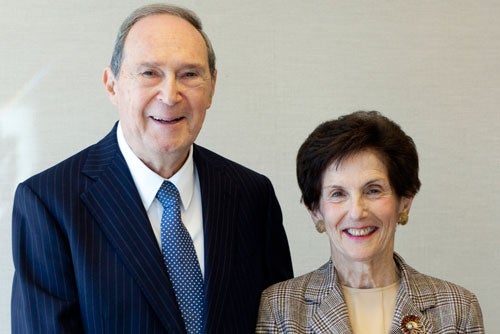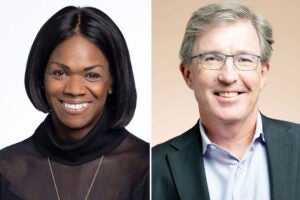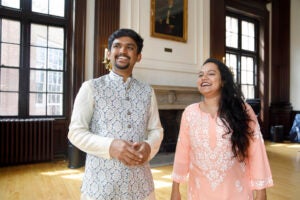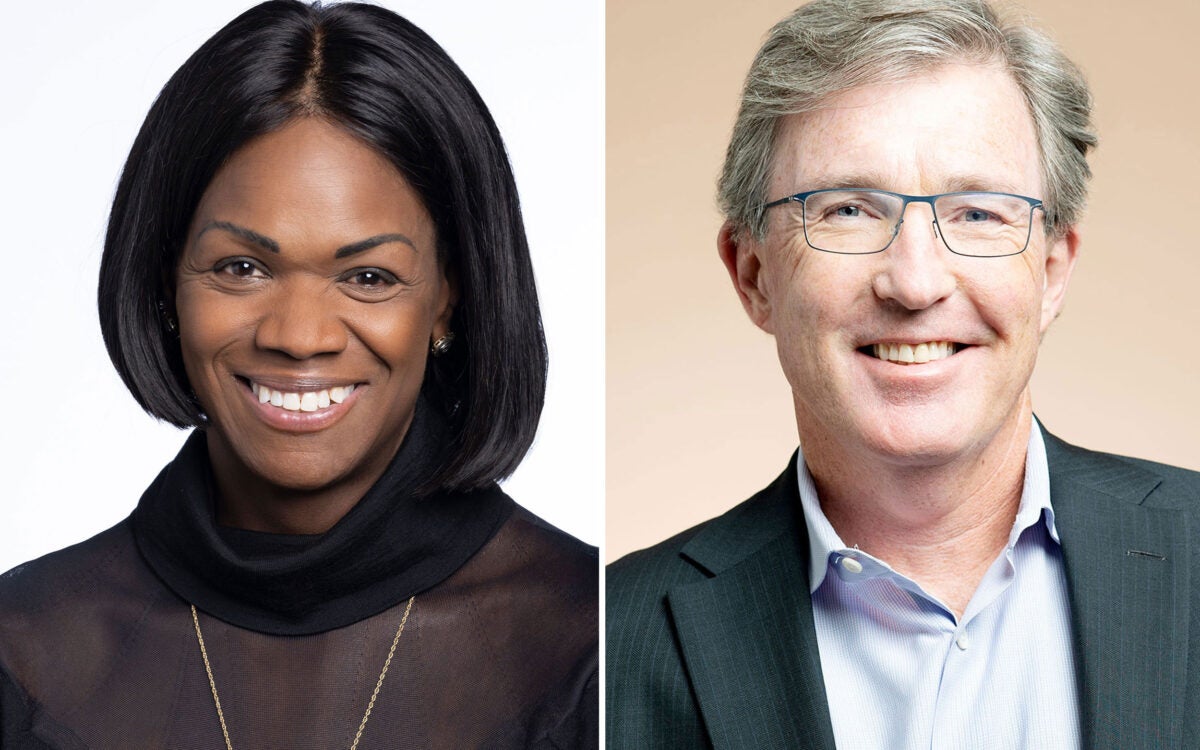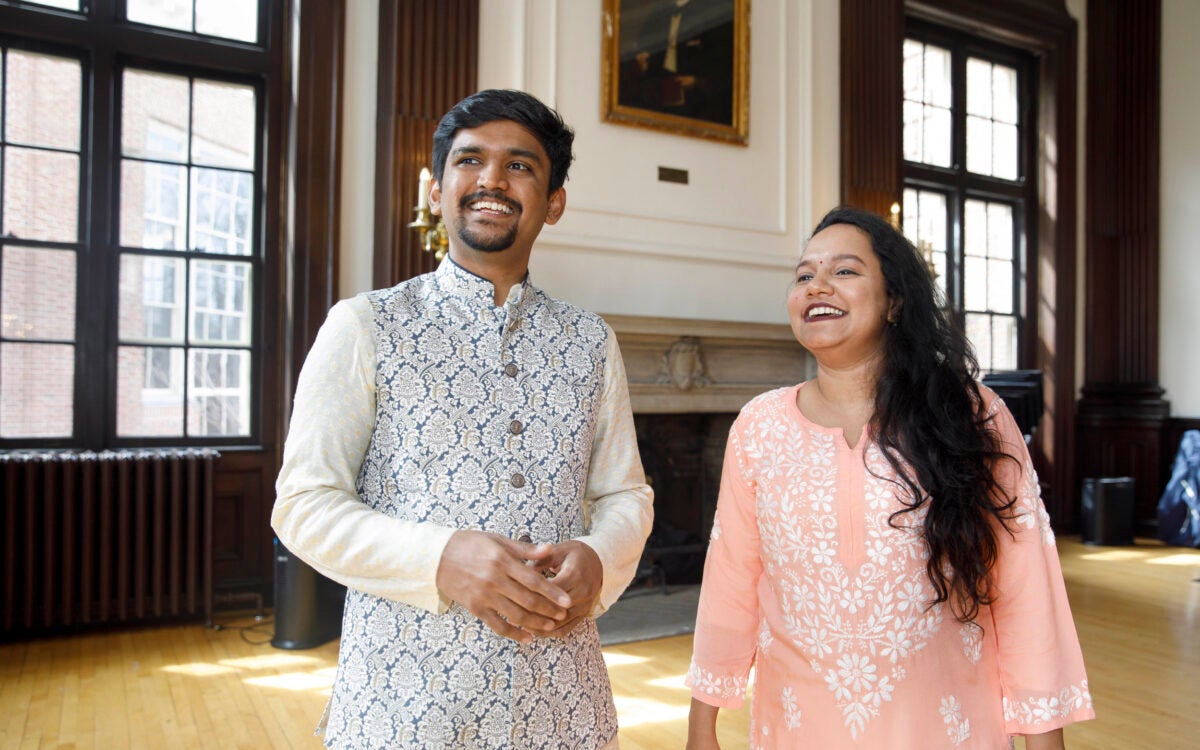Rose Lincoln/Harvard Staff Photographer
Education and innovation
Harvard receives $40 million for innovative teaching and learning
Harvard University announced today that Rita E. and Gustave M. Hauser have given the University $40 million to support excellence and innovation in learning and teaching at Harvard.
The gift will launch an initiative for learning and teaching and serve as a catalyst for transforming students’ educational experiences University-wide. The fund will enable the University to marshal its considerable intellectual resources to engage a new generation of students with pioneering teaching practices, building on the long history of educational reform at Harvard. The new gift combines the Hausers’ passions for technology, a global outlook, and teaching and learning with a desire to make an impact on both a University-wide and global scale.
“Dramatic developments in technology and research aimed at understanding how people learn are radically changing the practice of teaching, offering instructors new and exciting ways to engage with students,” said Harvard President Drew Faust. “This remarkable gift from the Hausers will allow us to support the efforts of our enormously creative faculty and provide a framework for making excellent teaching and engagement between faculty and students the touchstone of the educational experience at Harvard.”
“Our gift is intended to support Harvard’s leadership at a very significant moment in higher education,” said Gustave Hauser, LL.B. ’53. “There is a whole generation of new students who require new teaching and learning methods. This project focuses Harvard’s enormous resources on making higher education more effective.”
“This is in line with the philosophy of our giving,” said Rita Hauser, Harvard Law School ’58. “We are giving a sizable gift, which is just the beginning … This is really a startup if you like, and we hope it will be a catalytic gift.
“We hope that this gift will be one that will touch all places in the University and help to bring the University together. We also hope that other people are going to see the potential of this gift, and in ways that none of us can contemplate. Innovative teaching and learning is the future, not just for Harvard, but for universities in general.”
The new initiative will advance a range of projects, beginning with a University-wide conference in February that will bring together top thinkers, from both within and outside Harvard, in a range of fields related to pedagogical practices and the science of learning. Harvard will also use this funding to enhance classroom spaces for use by Schools across the University through designs that will allow for experimental teaching methods and the flexible use of a variety of technologies.
In addition, the initiative will include a grant program to support innovative teaching projects across Harvard’s Schools. The grants — available to University faculty, deans, administrators, and students — will, over time, support both innovative ideas from individuals and structured projects that are central to the curricular planning and pedagogy of Harvard’s Schools. For more information on grant guidelines, please visit harvard.edu/sites/default/files/content/HILT-guidelines_111018.pdf.
“This gift is a huge affirmation of Harvard’s ongoing commitment to excellent teaching,” said Harvard Dean of the Faculty of Arts and Sciences Michael D. Smith. “Since the ’70s, we have had one of the world’s most highly regarded centers focused on teaching undergraduates. As we look to the future, the Derek Bok Center for Teaching and Learning will expand its efforts to bring insights from the science of learning into the classroom. Visionary investments in activities like these will establish Harvard as the institution for pedagogical innovation.”
“New technologies have transformed the way students interact with the world, with information, and knowledge,” said Dean of Harvard College Evelynn M. Hammonds. “With the new gift, Harvard can explore how best to meet students where they are and update the kind of teaching we have done so well in the past with new kinds of tools.”
Harvard’s commitment to educational reform is longstanding. Harvard President Charles Eliot (term of office: 1869-1909) introduced the elective system. His successor, A. Lawrence Lowell (1909-1933), gave Harvard general examinations, fields of concentration, and tutorials. President James Bryant Conant (1933-1953) adopted the SAT to identify talented students from a broad range of high schools.
Revolutionary in a similar way was the case method, introduced by Harvard Law School (HLS) in the 1870s. It quickly became the dominant teaching model in U.S. law. In 1920, Harvard Business School adopted the case method teaching technique. And in the sciences, Harvard Medical School restructured traditional medical education in 1985, when it adopted the New Pathway in General Medical Education. The revised system of learning acknowledged a greater need for analytical tools, adaptable skills, and flexible attitudes for lifelong learning.
Most recently, in 2009, Harvard College revamped its General Education curriculum. Undergraduate core courses, newly defined, let students readily connect what they learn in the classroom to the wider world.
The new Hauser-backed initiative builds on the strengths of proven methods and the momentum of curricular exploration at Harvard to incorporate and study groundbreaking techniques that aim to transform students’ learning experiences.
“We as an institution remain very much unfinished. … We are constantly trying to get better and recognizing that we must be better. At the core of that is experimentation and innovation,” said Youngme Moon, Donald K. David Professor of Business Administration, senior associate dean, and chair of Harvard Business School’s M.B.A. program.
“This gift is so vital because it allows faculty the opportunity to innovate and experiment — to step back and think of new ways to engage our students, and it provides the impetus for all University faculties to share best practices and work together,” said Jules Dienstag, dean for medical education at Harvard Medical School. “The Hauser gift gives us new resources to devote to innovation in teaching and learning.”
The new initiative will operate in collaboration with the broad array of University efforts devoted to enhancing education, such as learning centers and academic instructional support units across Harvard’s campuses.
The gift is one of many given to Harvard by the Hausers over the years. Examples include a gift for the construction of Harvard Law School’s Hauser Hall in 1994; the founding of the Hauser Center for Nonprofit Organizations at Harvard University in 1997, a University-wide center for the study of nonprofit organizations and civil society; the endowment of the Chair in Human Rights and Humanitarian Law at HLS in 1998; and their support of an interfaculty initiative on human rights studies the same year.
In looking to the future, Faust said she hopes the new gift will allow Harvard’s commitment to teaching and learning to be understood both within the Harvard community and beyond “as a fundamental part of who we are, at the very core of Harvard’s identity.”
The gift embodies the Hausers’ “real citizenship, loyalty, and generosity to Harvard, and their deep commitment to innovative teaching,” added Faust. “It’s been an exciting set of interactions leading to this moment, and we thank them for this marvelous gift.”
